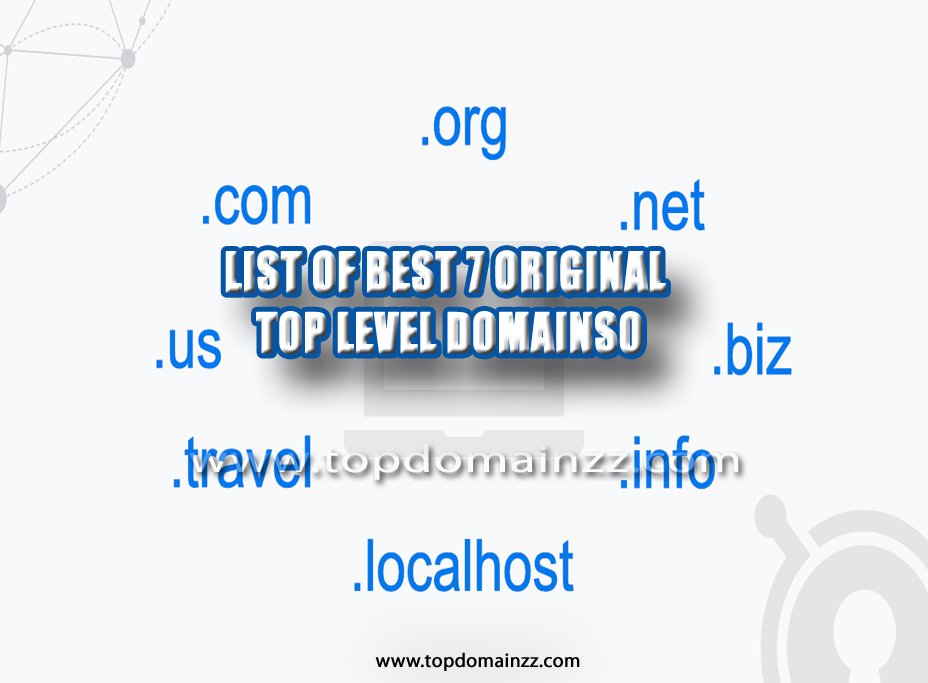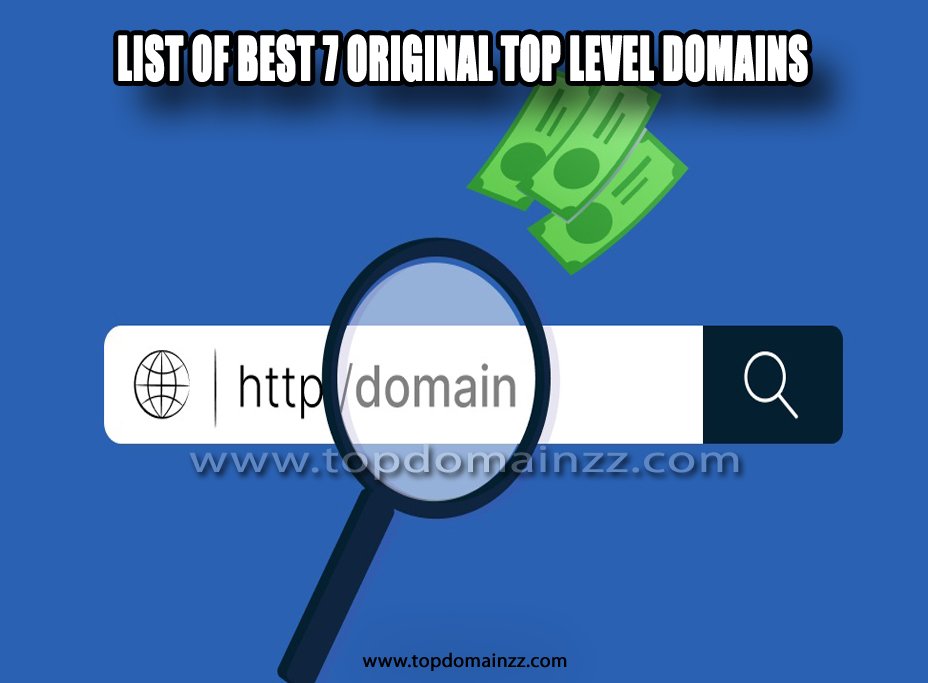List of best 7 Original top level domains
Introduction:
In the huge breadth of the top level domains, area names act as computerized land that gives a location to sites and online administrations. At the core of every space name is the top level domains (TLD), the postfix that follows the last spot in a web address. TLDs are key parts of the Web foundation, working with route and association in the advanced domain.
Throughout the long term, the Web has seen the development of numerous TLDs, each centered around unambiguous purposes, networks, or areas. Among them, the first high-level spaces have an exceptional spot, which addresses the primary mainstays of the Web area naming framework. In this article, we dive into the beginnings, importance, and development of the main 7 Original top level domains and analyze their effect on the computerized scene.
1. .com (commercial)– One of the best top level domains
Seemingly the most notable and perceived TLD, .com initially meant “business” and was planned for business elements when it was first presented in 1985. Nonetheless, its unassuming nature immediately prompted its far and wide reception beyond business use. Today, .com spaces are inseparable from the actual Web and act as the default decision for organizations, associations, and people.
The prominence of .com areas can be credited to a few elements, including their widespread acknowledgment, saw validity, and memorability. The .com augmentation conveys intrinsic trust and authenticity according to Web clients, going with it the favored decision for laying out an internet-based presence. Moreover, the absence of short, paramount .com spaces has prompted their appropriateness and premium costs in the reseller’s exchange.
Despite the presentation of numerous option TLDs, .com stays unparalleled regarding worldwide significance and market predominance. It’s getting through bid highlights its status as a center TLD of the Web time, rising above its unique business assignment to turn into an image of a computerized personality and network.
The universal idea of .com areas has prompted their mix into mainstream society, with references to “website” filling in as shorthand for everything Web-related. Sites with a .com expansion cover a different scope of ventures, interests, and purposes, from online business monsters to individual web journals. In a serious web-based climate, getting a critical .com space is many times considered fundamental to making a brand personality, drawing in guests, and building trust among purchasers.
Furthermore, the globalization of trade and the ascent of worldwide partnerships have expanded the worth of .com spaces as widespread identifiers in the worldwide commercial center. Whether focusing on a neighborhood or worldwide crowd, organizations frequently favor the .com expansion to convey a feeling of validity and cross-line openness. Accordingly, interest in .com spaces major area of strength for stays, ceaseless development, and interest in the area of business.
In any case, the ubiquity of .com spaces has additionally prompted issues, including area crouching, brand name debates, and the commodification of beneficial space names. As important advanced resources, premium .com areas can order expanded costs on the optional market, making them unreasonably expensive for more modest organizations and people. Furthermore, the immersion of accessible .com areas has prodded the presentation of option TLDs that offer new open doors for marking and separation in the web-based space.
All in all, the .com TLD is a demonstration of persevering through the force of straightforwardness, flexibility, and memorability in the computerized age. Notwithstanding the expansion of option TLDs, .com stays at the best quality level for online characters and encapsulates the substance of business, availability, and local area on the Web.

2. .net (network)
Presented close by .com in 1985, .net was initially expected for elements engaged with network innovation and foundation. While .com has turned into the true decision for business undertakings, .net has tracked down its place among ISPs, framework suppliers, and organization-related associations.
The .net TLD represents availability and cooperation in the advanced domain, mirroring the principal job of organizations in working with correspondence and information trade. Sites with .net spaces frequently convey a feeling of specialized skill and local area contribution, and appeal to a group of people keen on Web framework and systems administration innovations.
Albeit .net spaces are not so omnipresent as .com, they stay a famous decision for organizations and associations that stress their contribution to the advanced biological system. Likewise, a few people and substances settle on .net spaces when their ideal .com partner isn’t accessible, exploiting the TLD’s relationship with systems administration and availability.
The getting through the allure of .net areas lies in their flexibility and importance in an undeniably associated world. As the Web keeps on advancing, the requirement for a strong organizational foundation and solid availability stays principal, expanding the interest for .net areas among substances at the cutting edge of mechanical advancement.
Moreover, the worldwide development of Web access and the expansion of associated gadgets has highlighted the significance of organization versatility and adaptability, further enhancing the significance of .net spaces in working with computerized correspondence and joint effort.
All in all, the .net TLD fills in as a signal for associations and people focused on developing the connectedness of the computerized world. As organizations become an undeniably necessary piece of every part of present-day life, .net spaces keep on assuming an essential part in forming the framework of the Web, empowering the consistent progression of data across lines and limits.
3. .organization (Organization)
As the name proposes, the organization was initially planned for non-benefit associations and different elements participated in magnanimous, instructive, or altruistic exercises. Presented in 1985 close by .com and .net, .organization immediately became inseparable from associations focused on friendly great and public help.
The organization TLD conveys implications of trust, uprightness, and selflessness, making it an optimal decision for non-benefit associations, vested parties, and local area drives. Sites bearing the organization’s expansion frequently motivate trust and a feeling of direction, interesting to people who need to help noble purposes or participate in grassroots developments.
Despite its planned use for non-business substances, .organization has additionally been taken on by different for-benefit associations, especially those zeroed in on friendly effect or local area commitment. While this takeoff from its unique reason has ignited banters about the respectability of the organization namespace, the TLD keeps on filling in as a stage for progressing significant causes and supporting web-based networks.
The perseverance the allure of organization spaces lie in their relationship with social obligation and aggregate activity. During a time set apart by friendly and natural difficulties, the organization TLD gives a computerized space to people and associations to prepare assets, bring issues to light, and advance positive change on a worldwide scale.
Likewise, the straightforwardness and responsibility inborn in the organization assignment highlights the significance of a moral way of behaving and great administration in the philanthropic area. By sticking to laid out principles of uprightness and responsibility, organization substances can assemble trust and validity with partners, encourage long-haul connections, and augment their effect on society.
All in all, the organization TLD addresses a computerized shelter for associations and people who need to affect the planet. .organization sites act as encouraging signs and impetuses for change in an always developing scene of difficulties and open doors, whether pushing for civil rights, advancing natural maintainability, or propelling philanthropic objectives.
4. .gov (government)
Not at all like the open and unlimited nature of nonexclusive TLDs, for example, .com and .net, .gov is saved solely for use by government organizations and substances at the bureaucratic, state, and neighborhood levels. Presented in 1985 as a component of the first arrangement of TLDs, .gov fills in as a confided-in mark of true government sites and online administrations.
The .gov TLD epitomizes authority, authenticity, and responsibility the job of government organizations is to serve the public interest and advance popularity-based standards. Sites with a .gov expansion stick to severe norms of legitimacy and security, guaranteeing that residents approach dependable data and administrations from licensed sources.
Because of its confined nature, getting a .gov space requires a severe confirmation process directed by the General Administration Organization (GSA) in the US. This cycle guarantees that main genuine government elements can enroll and keep up with .gov spaces, safeguards the trustworthiness of the namespace, and shields residents from deception and extortion.
The reception of .gov areas has extended lately because of the rising digitization of taxpayer-driven organizations and the rising significance of online correspondence in policy management. .gov areas act as confided-in passages to crucial data, assets, and administrations for residents, from true sites for bureaucratic organizations to neighborhood government entries.
All in all, the .gov TLD fills in as a foundation of computerized administration, giving a safe and confided-in stage for government substances to speak with residents and convey fundamental administrations. As legislatures embrace computerized change and endeavor to meet the developing necessities of their constituents, .gov spaces will keep on assuming a focal part in forming the eventual fate of policy management and popularity-based administration.

5. .mil (military)
Like .gov, the .mil TLD is held for a particular subset of clients — for this situation, parts of the military and protection associations. Presented in 1985 alongside other unique TLDs, .mil fills in as a different namespace for military sites, correspondences, and online assets.
Sites with .mil spaces are devoted to the necessities of military faculty, veterans, and regular citizen workers associated with safeguard and public safety endeavors. The .mil TLD represents Strength, Discipline, and Public Protection, mirroring the basic idea of the associations it addresses.
Because of the delicate idea of military activities and the significance of safety, the enrollment and organization of .mil areas are dependent upon severe oversight and adherence to laid out conventions. This guarantees that main approved people and substances can get to and keep up with .mil sites, lessening the gamble of unapproved access or abuse by pernicious entertainers.
As well as filling in as a stage for inside correspondence and cooperation inside the military, .mil spaces assume an essential part in open effort and data spread. Military sites give significant assets to support individuals, veterans, and the overall population, offering bits of knowledge into military history, culture, and tasks.
Also, the .mil TLD features military associations’ obligation to straightforwardness, responsibility, and public commitment. By keeping up with true sites with .mil spaces, military elements exhibit their obligation to open correspondence and public trust, cultivating a feeling of solidarity and mutual perspective among partners.
All in all, the .mil TLD fills in as a computerized fort for military associations, giving a protected and dependable stage for correspondence, joint effort, and public effort. As the job of innovation in safeguarding develops and digital risks become more modern, .mil spaces will keep on assuming a basic part in guaranteeing public safety and safeguarding the interests of military faculty and people in general.
6. .edu (Education)
Presented in 1985 alongside other unique TLDs, .edu is saved for certify post-auxiliary instructive organizations, including colleges, universities, and examination foundations. The .edu TLD fills in as a characteristic of scholastic greatness and insightful action, recognizing instructive sites from other web-based content.
Sites with .edu spaces offer an abundance of assets and data connected with advanced education, scholarly projects, research drives, and institutional contributions. The .edu expansion conveys validity, mastery, and scholarly thoroughness, making it a confided-in objective for understudies, educators, specialists, and deep-rooted students.
The .edu space enlistment process is managed by EDUCAUSE, a non-benefit association devoted to progressing advanced education through data innovation. Foundations trying to obtain or keep up with .edu areas should exhibit their certification status and consistence with EDUCAUSE’s qualification measures and guarantee the honesty and notoriety of the .edu namespace.
As well as filling in as computerized centers for scholastic establishments, .edu spaces assume an imperative part in elevating admittance to schooling and advancing information sharing on a worldwide scale. Instructive sites with the .edu expansion offer a different scope of assets, including on-the-web courses, research distributions, and scholarly discussions, that enhance the opportunity for the growth of understudies and instructors all over the planet.
Likewise, the .edu TLD works with cooperation and associations between instructive establishments, empowering cross-institutional drives and interdisciplinary examination endeavors. By giving a typical stage to information trade and joint effort, .edu spaces add to the improvement of grants and development across various fields of study.
All in all, the .edu TLD addresses an entryway to the universe of advanced education, offering rich open doors for learning and scholarly investigation. As foundations embrace advanced change and online training keeps on acquiring conspicuousness, .edu areas will stay fundamental apparatuses for interfacing understudies, teachers, and specialists in their quest for scholarly greatness and cultural advancement.
7. .int (worldwide organization)
Albeit less conspicuous than other local TLDs, .int has importance as an assigned space for worldwide associations laid out by intergovernmental deals or arrangements. Presented in 1988, .int fills in as a specific namespace for elements engaged with worldwide participation, discretion, and philanthropic endeavors.
Sites with .int spaces address a different scope of worldwide associations, including intergovernmental organizations, discretionary missions, deal bodies, and transnational drives. The .int TLD highlights the transnational idea of these associations and underlines their obligation to address worldwide difficulties and advance harmony, improvement, and collaboration.
The .int space enlistment process is overseen by the Web Doled out Numbers Authority (IANA), which supervises the assignment of high-level areas and oversees the worldwide space name framework. Associations chasing .int areas should meet severe qualification rules and show their status as genuine global substances perceived by the worldwide local area.
As well as filling in as computerized stages for worldwide discretion and participation, .int spaces assume an essential part in working with helpful guide and crisis reaction endeavors. .int associations utilize their worldwide reach and institutional authenticity to assemble assets, coordinate aid ventures, and address weak populations amid emergencies.
Also, the .int TLD advances fortitude and participation between countries, rises above international limits, and advances exchange and common grasping on issues of worldwide significance. By giving a typical computerized space to worldwide associations, .int spaces add to the improvement of multilateralism and the quest for shared objectives to improve humankind.
All in all, the .int TLD fills in as a computerized span between countries, supporting collaboration, tact and aggregate activity on the worldwide stage. As the world turns out to be progressively interconnected and related, .int spaces will keep on assuming a crucial part in advancing harmony, flourishing, and supportable improvement across lines and societies.

Conclusion:
All in all, unique high-level spaces are the backbones of the Web’s area naming framework, each filling an alternate need and crowd. From the general allure of .com to the authority of .gov, these TLDs assume a crucial part in forming web characters, working with correspondence, and establishing trust in the computerized climate.
While more current TLDs have multiplied as of late, the first seven TLDs keep on deserving admiration and acknowledgment as foundations of the Web framework. Their perseverance through significance highlights the persevering through standards of network, trust, and coherence that have characterized the Web since its commencement. As the Web develops and grows, these unique TLDs stay unflinching, giving a natural and confided-in structure for exploring the huge virtual domain.
While advancement and trial and error with new TLDs are crucial for meeting the different requirements of the consistently developing web-based local area, the key significance of the first TLDs fills in as a sign of the Web’s starting points and the rules that have directed its improvement throughout the long term. The first high-level spaces represent the past, yet in addition act as a signal that directs the future improvement of the Web and guarantees that it stays comprehensive, open, and dependable for a long time into the future.

